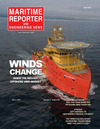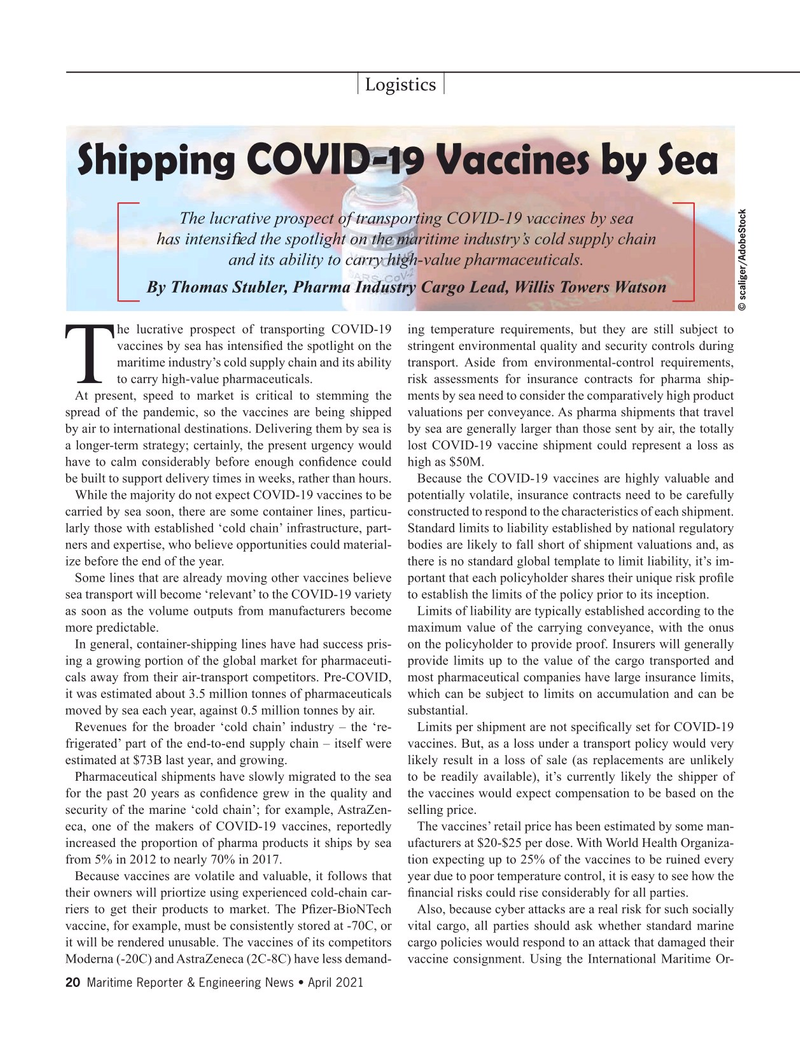
Page 20: of Maritime Reporter Magazine (April 2021)
Offshore Wind Energy: Installation, Crew & Supply Vessels
Read this page in Pdf, Flash or Html5 edition of April 2021 Maritime Reporter Magazine
Logistics
Shipping COVID-19 Vaccines by Sea
The lucrative prospect of transporting COVID-19 vaccines by sea has intensi? ed the spotlight on the maritime industry’s cold supply chain and its ability to carry high-value pharmaceuticals.
By Thomas Stubler, Pharma Industry Cargo Lead, Willis Towers Watson © scaliger/AdobeStock he lucrative prospect of transporting COVID-19 ing temperature requirements, but they are still subject to vaccines by sea has intensi? ed the spotlight on the stringent environmental quality and security controls during maritime industry’s cold supply chain and its ability transport. Aside from environmental-control requirements,
T to carry high-value pharmaceuticals. risk assessments for insurance contracts for pharma ship-
At present, speed to market is critical to stemming the ments by sea need to consider the comparatively high product spread of the pandemic, so the vaccines are being shipped valuations per conveyance. As pharma shipments that travel by air to international destinations. Delivering them by sea is by sea are generally larger than those sent by air, the totally a longer-term strategy; certainly, the present urgency would lost COVID-19 vaccine shipment could represent a loss as have to calm considerably before enough con? dence could high as $50M.
be built to support delivery times in weeks, rather than hours. Because the COVID-19 vaccines are highly valuable and
While the majority do not expect COVID-19 vaccines to be potentially volatile, insurance contracts need to be carefully carried by sea soon, there are some container lines, particu- constructed to respond to the characteristics of each shipment. larly those with established ‘cold chain’ infrastructure, part- Standard limits to liability established by national regulatory ners and expertise, who believe opportunities could material- bodies are likely to fall short of shipment valuations and, as ize before the end of the year. there is no standard global template to limit liability, it’s im-
Some lines that are already moving other vaccines believe portant that each policyholder shares their unique risk pro? le sea transport will become ‘relevant’ to the COVID-19 variety to establish the limits of the policy prior to its inception.
as soon as the volume outputs from manufacturers become Limits of liability are typically established according to the more predictable. maximum value of the carrying conveyance, with the onus
In general, container-shipping lines have had success pris- on the policyholder to provide proof. Insurers will generally ing a growing portion of the global market for pharmaceuti- provide limits up to the value of the cargo transported and cals away from their air-transport competitors. Pre-COVID, most pharmaceutical companies have large insurance limits, it was estimated about 3.5 million tonnes of pharmaceuticals which can be subject to limits on accumulation and can be moved by sea each year, against 0.5 million tonnes by air. substantial.
Revenues for the broader ‘cold chain’ industry – the ‘re- Limits per shipment are not speci? cally set for COVID-19 frigerated’ part of the end-to-end supply chain – itself were vaccines. But, as a loss under a transport policy would very estimated at $73B last year, and growing. likely result in a loss of sale (as replacements are unlikely
Pharmaceutical shipments have slowly migrated to the sea to be readily available), it’s currently likely the shipper of for the past 20 years as con? dence grew in the quality and the vaccines would expect compensation to be based on the security of the marine ‘cold chain’; for example, AstraZen- selling price. eca, one of the makers of COVID-19 vaccines, reportedly The vaccines’ retail price has been estimated by some man- increased the proportion of pharma products it ships by sea ufacturers at $20-$25 per dose. With World Health Organiza- from 5% in 2012 to nearly 70% in 2017. tion expecting up to 25% of the vaccines to be ruined every
Because vaccines are volatile and valuable, it follows that year due to poor temperature control, it is easy to see how the their owners will priortize using experienced cold-chain car- ? nancial risks could rise considerably for all parties.
riers to get their products to market. The P? zer-BioNTech Also, because cyber attacks are a real risk for such socially vaccine, for example, must be consistently stored at -70C, or vital cargo, all parties should ask whether standard marine it will be rendered unusable. The vaccines of its competitors cargo policies would respond to an attack that damaged their
Moderna (-20C) and AstraZeneca (2C-8C) have less demand- vaccine consignment. Using the International Maritime Or- 20 Maritime Reporter & Engineering News • April 2021
MR #4 (18-33).indd 20 4/1/2021 11:31:17 AM

 19
19

 21
21
